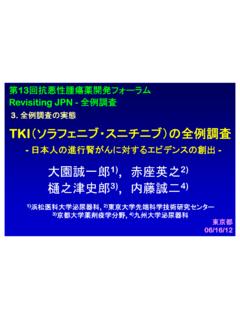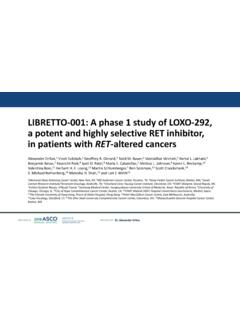Transcription of DRUG NAME: Pazopanib - BC Cancer
1 Pazopanib BC Cancer Agency Cancer drug Manual Page 1 of 7 Pazopanib Developed: 1 October 2011 Revised: 1 October 2015 drug name : Pazopanib SYNONYM(S): Pazopanib hydrochloride, GW7860341 COMMON TRADE name (S): VOTRIENT CLASSIFICATION: vascular endothelial growth factor receptor (VEGFR) tyrosine kinase inhibitor Special pediatric considerations are noted when applicable, otherwise adult provisions apply. MECHANISM OF ACTION: Pazopanib is an orally active tyrosine kinase inhibitor of vascular endothelial growth factor receptor (VEGFR-1,-2, -3), platelet-derived growth factor receptor (PDGFR- ,- ), and stem cell factor receptor (c-KIT).2 Similar to sunitinib or sorafenib, Pazopanib is reported to block tumour growth by interfering with angiogenesis.
2 Pazopanib is also an inhibitor of fibroblast growth factor receptor (FGFR-1 and -3), the interleukin receptor (IL-2 ), and transmembrane glycoprotein receptor tyrosine kinase (c-Fms).3-5 PHARMACOKINETICS: Oral Absorption 14-39%6; increased with food or crushed tablet; time to peak plasma concentration 2-4 h; solubility is pH dependent (reduced absorption with increasing pH)7 Distribution highly protein bound to P-glycoprotein (Pgp) and Breast Cancer Resistant Protein (BCRP) cross blood brain barrier? no information found volume of distribution no information found plasma protein binding > 99% Metabolism primarily by CYP 3A4, minor metabolism by CYP 1A2 and CYP 2C8 active metabolite(s)6 activity not characterized inactive metabolite(s)6 activity not characterized Excretion primarily in feces urine < 4% feces 60-70% unchanged; 7-15% as metabolites terminal half life 31 h clearance no information found Adapted from standard reference2 unless specified otherwise.
3 USES: Primary uses: Other uses: *Renal cell carcinoma *Health Canada approved indication SPECIAL PRECAUTIONS: Contraindications: thrombotic event within the previous 6 months2 Pazopanib BC Cancer Agency Cancer drug Manual Page 2 of 7 Pazopanib Developed: 1 October 2011 Revised: 1 October 2015 Caution: in patients with uncontrolled or significant cardiac disease including hypertension, myocardial infarction/ischemia, congestive heart failure, left ventricular ejection fraction less than 45% or QT prolongation2,8; see paragraph in Side Effects section Hepatotoxicity (including hepatic failure and fatalities) has been reported. Liver enzyme tests are recommended at baseline and at routine intervals during treatment. Caution is advised in patients with a baseline bilirubin greater than X ULN and/or AST greater than 2 X ,10 See paragraph in Side Effects section.
4 Concomitant use of simvastatin may increase the risk of ALT ,10 See Interactions section. Wound healing complications are a risk for VEGF inhibitors. Hold Pazopanib for at least 7 days prior to surgery and resume 4 weeks after surgery based on clinical judgment of adequate wound Potential drug interactions involving CYP 3A4, P-glycoprotein, BCRP, UGT1A1 or OATP1B1 may affect the absorption or elimination of See paragraph in Interactions section. Carcinogenicity: no information found Mutagenicity: Not mutagenic in Ames test and mammalian in vitro mutation test. Pazopanib is not clastogenic in in vitro chromosome Fertility: In female animals, Pazopanib reduced fertility by loss of implantation, early resorption, decreased corpora lutea and ovarian atrophy.
5 Male fertility was not affected in animal Pregnancy: FDA Pregnancy Category There is positive evidence of human fetal risk, but the benefits from use in pregnant women may be acceptable despite the risk ( , if the drug is needed in a life-threatening situation or for a serious disease for which safer drugs cannot be used or are ineffective). In animal studies, Pazopanib has been shown to be teratogenic, causing cardiovascular malformations, delayed ossification, reduced fetal body weight, and loss of embryo. It is advisable to avoid becoming pregnant while receiving Pazopanib and for up to 8 weeks after ending Breastfeeding is not recommended due to the potential secretion into breast SIDE EFFECTS: The table includes adverse events that presented during drug treatment but may not necessarily have a causal relationship with the drug .
6 Because clinical trials are conducted under very specific conditions, the adverse event rates observed may not reflect the rates observed in clinical practice. Adverse events are generally included if they were reported in more than 1% of patients in the product monograph or pivotal trials, and/or determined to be clinically ORGAN SITE SIDE EFFECT Clinically important side effects are in bold, italics blood and lymphatic system/ febrile neutropenia leucopenia (37%, severe 0%) lymphopenia (31%, severe 4%) neutropenia (34%, severe 1%) thrombocytopenia (32%, severe <1%) cardiac (see paragraph following Side Effects table) congestive heart failure and decreased LVEF (<1%) myocardial infarction/ischemia (<2%) endocrine hypothyroidism (3%)12 TSH, elevated (29%, severe 4%)12 gastrointestinal emetogenic potential.
7 Low13 abdominal pain (11%, severe 2%) Pazopanib BC Cancer Agency Cancer drug Manual Page 3 of 7 Pazopanib Developed: 1 October 2011 Revised: 1 October 2015 ORGAN SITE SIDE EFFECT Clinically important side effects are in bold, italics diarrhea (52%, severe 3%)14; plasma Pazopanib concentration-dependent15 dyspepsia (5%) nausea (26%, severe <1%) pancreatitis (<1%) perforation or fistula (<1%, severe <1%)6,11 rectal hemorrhage (1%) stomatitis (4%); plasma Pazopanib concentration-dependent15 vomiting (21%, severe 2%) weight loss (9%) general disorders and administration site conditions asthenia (14%, severe 3%) chest pain, non-cardiac (5 %) fatigue (19%, severe 2%) hepatobiliary hepatic function, abnormal (3%) hepatotoxicity (2%, severe <1%)2,16; see paragraph following Side Effects table infections and infestations urinary tract infection (4%) investigations ALT, increased (53%, severe 10-18%)2,17; plasma Pazopanib concentration-dependent15; see paragraph following Side Effects table AST, increased (53%, severe 7%); see paragraph following Side Effects table creatinine, increased (26%, severe <1%) hyperbilirubinemia (36%, severe 3%).
8 See paragraph following Side Effects table hypocalcemia (33%, severe 1%) hypomagnesemia (26%, severe 1%) hyponatremia (31%, severe 4%) hypophosphatemia (34%, severe 4%) lipase, increased (4%) QT prolongation 500 msec (1%); see paragraph following Side Effects table serum amylase, increased (3%) Torsade de Pointes (<1%); see paragraph following Side Effects table metabolism and nutrition anorexia (22%, severe 2%) hypoglycemia (17%, severe <1%) hyperglycemia (41%, severe <1%) hyperkalemia (27%, severe 4%) nervous system dysgeusia (8%) headache (10%, severe 0%) paraesthesia (3%) transient ischemic attack (<2%) Pazopanib BC Cancer Agency Cancer drug Manual Page 4 of 7 Pazopanib Developed: 1 October 2011 Revised: 1 October 2015 ORGAN SITE SIDE EFFECT Clinically important side effects are in bold, italics renal and urinary dysuria (2%) hematuria (4%) proteinuria (9%, severe <1%)2,11 respiratory, thoracic and mediastinal epistaxis (2%) hemoptysis (2%) skin and subcutaneous tissue alopecia (8%) hair colour changes, depigmentation (38%).
9 Plasma Pazopanib concentration-dependent15 hyperhidrosis (3%) palmar-plantar erythrodysesthesia (6%); plasma Pazopanib concentration-dependent15 rash (8%) skin depigmentation (3%); following 1 or 2 cycles, dose-dependent3 vascular (see paragraph following Side Effects table) cerebral hemorrhage (<1%) cerebral vascular accident (<1%) hypertension (40%, severe 4%) hypertensive crisis (<1%) Adapted from standard reference2 unless specified otherwise. Arterial thrombotic events including myocardial infarctions, angina, ischemic stroke and transient ischemic attack were observed. Use with caution in those who are at increased risk of thrombotic events or who have had a history of thrombotic Cardiac dysfunction has been reported with decreases in left ventricular ejection fraction (LVEF).
10 2 Cardiac assessment for symptomatic congestive heart failure (CHF) or reduced LVEF may be Use caution in patients with LVEF less than 45%.8 Hypertension is common and usually occurs within the first 18 weeks of treatment. Persistent hypertension can be managed with antihypertensive agents or dose reductions of Pazopanib . Rarely, hypertensive crisis may occur in patients with or without a history of hypertension. In the event of hypertensive crisis or severe and persistent hypertension, discontinue QT Prolongation ( 500 msec) has been reported and may lead to Torsade de Pointes. Caution is advised in patients with a history of QT interval prolongation or taking antiarrhythmics or other medications that may prolong the QT interval.













